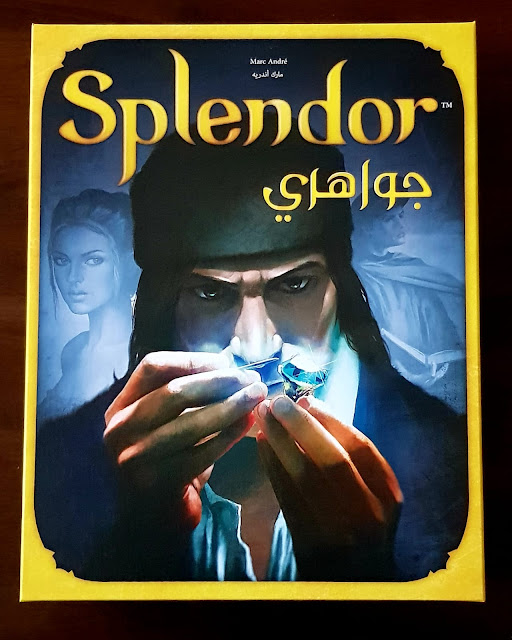Splendor
Splendor
|
Designer |
|
|
Publisher |
|
|
Age rating |
10+ |
|
Time |
30 min |
|
Players |
2-4 |
|
Fun |
3/5 |
|
Complexity |
3/5 |
Splendor - the game that makes collecting gems and buying assets interesting, even though in real life… well, you know, I’d love to collect gems and buy assets in real life too.
The gameplay, once you get into it, and it doesn’t take more than 10 minutes and one quick playthrough to explain, can get fast paced, but at times can get slow too. It all depends on how fast you can plan your next move. Every turn you take either two of the same type of gems, or three different ones. You can choose to hoard all types (but don’t forget the limit of 10 gems at the end of your turn) and buy any asset you can afford, or you can focus on one of the higher value assets and plan to get the gems you need for that one.
 |
| Setup for a two player game |
You can also reserve cards and use gold gems, but I found
this to be largely unnecessary and redundant, unless you want to block the other person from getting the chosen asset card. Another way of getting points is
to collect gem sets that bestow upon you the visits of nobles, and as these
bring you three points per visit, they are highly advised in my
opinion. The points are added up as you gain them, so you can clearly see if you need a single asset to win, or if you are sure to lose no matter what you do.
The problem that can come out of this is that the other
player might choose the same asset as you, and take the gems that you need to
achieve your goal. The wins in this game are rarely one sided; most often, it
comes down to a single point difference at the end of the game. Occasionally,
you might be in the situation where you need a ruby, but the other player is
hoarding them, whether intentionally or not, but those are rare cases. There is only a tiny bit of luck involved in the playing. Most of the wins depend on careful and smart planning ahead.
You play as gem merchants in the past, around the 17th century. As such, you will expand your wealth, purchase factories and mines, and fund caravans and gem artisans. Ultimately, you will earn enough prestige points, the measure of victory in the game, so that you attract the attention of noblemen of the time. These ideas really work for me, as I can easily imagine this happening, when the amount of things and gems I own rise exponentially, represented by the cards on the table in front of me.
Overall, Splendor is a game I would definitely recommend. I know trading gems and buying assets doesn’t sound as exciting as dungeon crawling and saving the world, but it has a unique charm to it. So go play Splendor, and become a gem merchant who expands his empire trade by trade.



Comments
Post a Comment